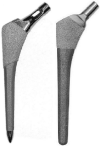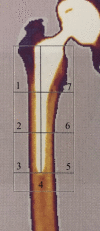No difference for changes in BMD between two different cementless hip stem designs 2 years after THA
- PMID: 33723344
- PMCID: PMC7971014
- DOI: 10.1038/s41598-021-85424-x
No difference for changes in BMD between two different cementless hip stem designs 2 years after THA
Abstract
This study evaluates how 2 different total hip arthroplasty (THA) stems compares regarding adaptive bone remodelling. The stems are both proximally porous coated, aiming for proximal fixation, but with different dispersal of the coating. They are also differently designed regarding the distal tip of the stem. We aimed to investigate if there is a difference in periprosthetic adaptive bone remodelling between two different designs. From February 2016 to September 2017, we randomised 62 patients, 1:1 (mean age = 64 years, Female/Male = 28/34), scheduled for an uncemented THA to receive either an EBM or a BM THA stem. We performed dual-energy x-ray absorptiometry (DEXA) scans within a week after surgery and at 3, 6, 12 and 24 months with measurements of bone mineral density (BMD) in the 7 Gruen zones (region of interest (ROI) 1-7). Additionally, Oxford Hip Score and Harris Hip Score were collected at 6, 12 and 24 months. We found a decrease in BMD between the postoperative and the 24-months values in all ROIs for both stems. The greatest decrease over time was seen for both groups in the ROI1 (BM = - 8.4%, p = 0.044, and EBM = - 6.5%, p = 0.001) and ROI7 (BM = - 7%, p = 0.005, and EBM = - 8.6%, p < 0.0005). We found a tendency in ROI2-4 of a higher degree of bone loss in the EBM group. However, this difference only continued beyond 6 months in ROI4 (24 months: BM = - 1.2% and EBM = - 2.8%, p = 0.001). The stems show similar adaptive bone remodelling and are clinically performing well.
Conflict of interest statement
The authors declare that there is no competing interests except for MMP, who reports grants from Zimmer Biomet during the conduction of the study.
Figures
Similar articles
-
Periprosthetic bone remodelling of two types of uncemented femoral implant with proximal hydroxyapatite coating: a 3-year follow-up study addressing the influence of prosthesis design and preoperative bone density on periprosthetic bone loss.Osteoporos Int. 2004 Apr;15(4):281-9. doi: 10.1007/s00198-003-1546-5. Epub 2003 Dec 6. Osteoporos Int. 2004. PMID: 14661072 Clinical Trial.
-
Comparison of periprosthetic bone mineral density between two types of short-stems in total hip arthroplasty with a mean follow-up of 4 years.Orthop Traumatol Surg Res. 2022 Feb;108(1):103044. doi: 10.1016/j.otsr.2021.103044. Epub 2021 Aug 10. Orthop Traumatol Surg Res. 2022. PMID: 34389498
-
Evaluation of Proximal Femoral Bone Mineral Density in Cementless Total Hip Arthroplasty: A 3-Arm Prospective Randomized Controlled Trial.J Bone Joint Surg Am. 2024 Mar 20;106(6):508-516. doi: 10.2106/JBJS.23.00449. Epub 2023 Dec 19. J Bone Joint Surg Am. 2024. PMID: 38113306 Clinical Trial.
-
Periprosthetic Bone Mineral Density Around Uncemented Titanium Stems in the Second and Third Decade After Total Hip Arthroplasty: A DXA Study After 12, 17 and 21 Years.Calcif Tissue Int. 2018 Oct;103(4):372-379. doi: 10.1007/s00223-018-0438-9. Epub 2018 Jun 1. Calcif Tissue Int. 2018. PMID: 29858615
-
Periprosthetic bone remodelling of short-stem total hip arthroplasty: a systematic review.Int Orthop. 2018 Sep;42(9):2077-2086. doi: 10.1007/s00264-017-3691-z. Epub 2017 Nov 27. Int Orthop. 2018. PMID: 29178044
References
-
- Rahmy AIA, Gosens T, Blake GM, Tonino A, Fogelman I. Periprosthetic bone remodelling of two types of uncemented femoral implant with proximal hydroxyapatite coating: a 3-year follow-up study addressing the influence of prosthesis design and preoperative bone density on periprosthetic bone loss. Osteoporos. Int. 2004;15:281–289. doi: 10.1007/s00198-003-1546-5. - DOI - PubMed
Publication types
MeSH terms
LinkOut - more resources
Full Text Sources
Other Literature Sources
Medical




